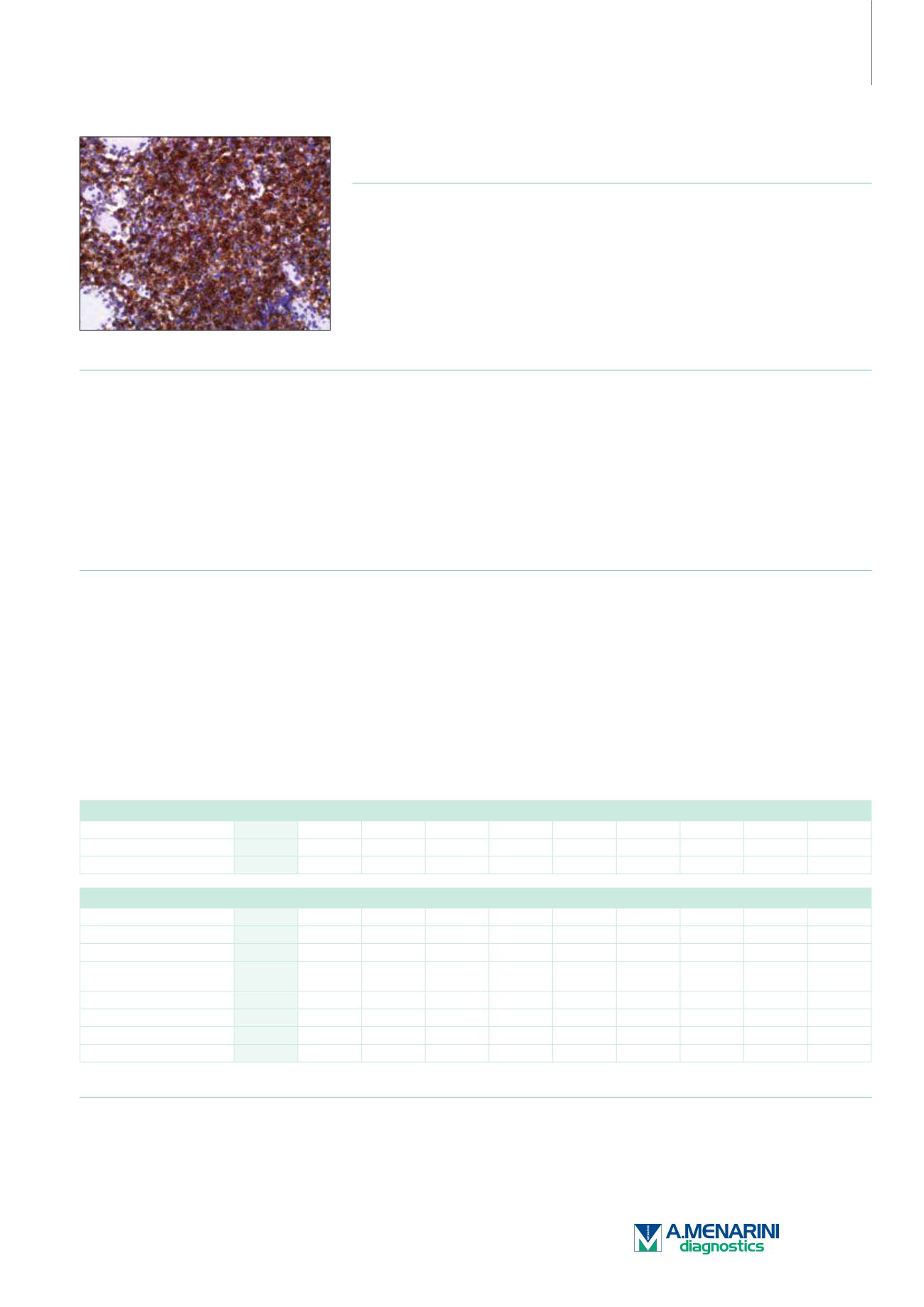
Advanced Solutions
for Advanced Pathology
CD7 (MRQ-56)
Mouse Monoclonal Antibody
Cat. No. Description
Volume
45188 IMPATH CD7 RTU M (MRQ-56)
50 Tests
44250 CD7 RTU M (MRQ-56)
7 ml Ready To Use
44521 CD7 0,1 M (MRQ-56)
100 µl liquid Concentrated
44522 CD7 1 M (MRQ-56)
1 ml liquid Concentrated
Product Specifications
Designation
IVD
Reactivity
Paraffin
Visualization
Membranous
Control
Peripheral T-cell lymphoma, Tonsil
Stability
Up to 36 mo. at 2-8°C
Isotype
IgG
1
Manual Protocol*
• Pretreatment: Heat Induced Epitope
Retrieval (HIER)
• Primary Antibody Incubation Time:
10-30min @ 25-37°C
• 2-step polymer detection
*Please refer to product insert for complete protocol.
ImPath Protocol*
• Dewax: Dewax Solution 2 (DS2)
• Pretreatment: Retrieval Solution pH 9.0
(TR1) 32min @ 98-103°C
• Primary Antibody Incubation Time:
10-90min @ 25-37°C
• HRP Polymer (Universal) or AP Polymer
(Universal) for 12 min
*Please refer to product insert for complete protocol.
Product Description
CD7 antigen is a cell surface glycoprotein of 40 kD expressed on the surface of immature and mature T-cells as well as natural killer (NK) cells. It is
a member of the immunoglobulin gene superfamily and is the first T-cell lineage associated antigen to appear in T-cell ontogeny, being expressed
in T-cell precursors (preceding CD2 expression), and in myeloid precursors, in fetal liver and bone marrow, and persisting in circulating mature
T-cells. While its precise function is not known, it is suggested that the molecule functions as an Fc receptor for IgM.
CD7 is the most consistently expressed T-cell antigen in lymphoblastic lymphomas and leukemias, and is therefore anti-CD7 is a useful marker
in the identification of such neoplastic proliferations. In mature post-thymic T-cell neoplasms, CD7 is the most common pan-T-antigen to be
aberrantly expressed, which is a useful pointer to a neoplastic T-cell process.
CD7 is immunoexpressed in 85% of mature peripheral T-cells, the majority of post-thymic T-cells, NK cells, T-cell lymphoblastic leukemia/
lymphoma, acute myeloid leukemia, and chronic myelogenous leukemia. CD7 is conspicuously absent in adult T-cell leukemia/lymphoma and is
not expressed in mycosis fungoides.
Lymphoblastic Lymphomas, B-cell vs. T-cell
CD7
TdT
CD10
PAX-5
CD20
CD19
CD3
CD5
CD117 CD1a
B-cell
-
+
+
+
+/-
+
-
-
-
+
T-cell
+/-
+
+/-
-
-
-
+
+/-
-/+
+/-
T-cell Lymphomas
CD7
CD45
CD2
CD3
CD4
CD5
CD8
CD25 CD45RO PD-1
Angioimmunoblastic
+
+
+
+
+
+
-
+
+
+
Lymphoblastic
+
+
+/-
+
+/-
+
+/-
+
+
-
Subcutaneous
Panniculitis-Like
+
+
+
+
-
+
+/-
-
+
-
NK
+/-
+
+
+
-
-
-
+
+
-
Cutaneous
+
+
+
+
+
-
-
-
-
-/+
Peripheral, NOS
+/-
+
+
+
+/-
+/-
-/+
+
+
-
Mycosis Fungoides
-
+
+
+
+
+
-
+
+
-
Reference
1. Hodak E, et al. J Am Acad Dermatol. 2006; 55:276-84
2. Went P, et al. J Clin Oncol. 2006; 24:2472-9.
3. Vonderheid EC. J Cutan Pathol. 2006; 33 Suppl 1:27-42.
49


